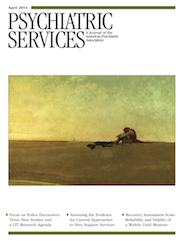It’s Time to Meet Our Criminal Justice Partners Halfway
Overrepresentation of people with mental disorders in criminal justice settings is well documented. Once an individual with a serious mental disorder is arrested, he or she will stay in custody longer—both pretrial and after sentencing—and return to jail more often than those without mental disorders. Individuals are caught in a costly cycle of arrest, release, and rearrest, with significant consequences to the pace of their recovery and to community safety.
In this issue, three articles report on studies that examined the interaction of law enforcement personnel and people with mental disorders. Charette and colleagues documented the substantial investment of scarce criminal justice resources required to respond to and resolve calls for assistance that involve people with mental illnesses. The authors note that few formal partnerships exist between the police and mental health systems and that without alternatives to jail, people with mental illnesses, particularly those with lower-level offenses, are more likely than people without disorders to be arrested. In two related studies, Compton and colleagues show that training can have a positive impact on officers’ attitudes toward people with mental disorders and on their ability to resolve calls with limited use of force and avoid justice system involvement. The authors note that “improving responses to persons with serious mental illnesses is now a national priority in law enforcement.” Many judges, corrections administrators, and policy makers recognize that use of jails to house people with mental disorders is both inappropriate and bad public policy.
This is not an issue that the criminal justice system can solve on its own. Although training and skill development for criminal justice personnel are laudable and necessary, they are not sufficient. Stigma and discrimination play a role not only in criminal justice system responses but also in responses of the behavioral health system to individuals involved with the justice system. With training for behavioral health providers on criminal proceedings, alternatives to incarceration, and evidence-based corrections practices, our willingness, confidence, and capacity to support effective interventions would increase. Walking through the arrest and jail experience would sensitize us to the negative impact of these events on an individual’s well-being. With better assessments, we would recognize the extent of criminal justice contact experienced by our patients—most of whom would put avoidance of subsequent contact high on their list of treatment objectives. With behavioral health performance measures that include number of arrests, length of incarceration, and recidivism rate, we would be held accountable for outcomes that can be mitigated through collaboration and partnership.
Like it or not, our mission includes improved public safety. Let’s get better at it!



